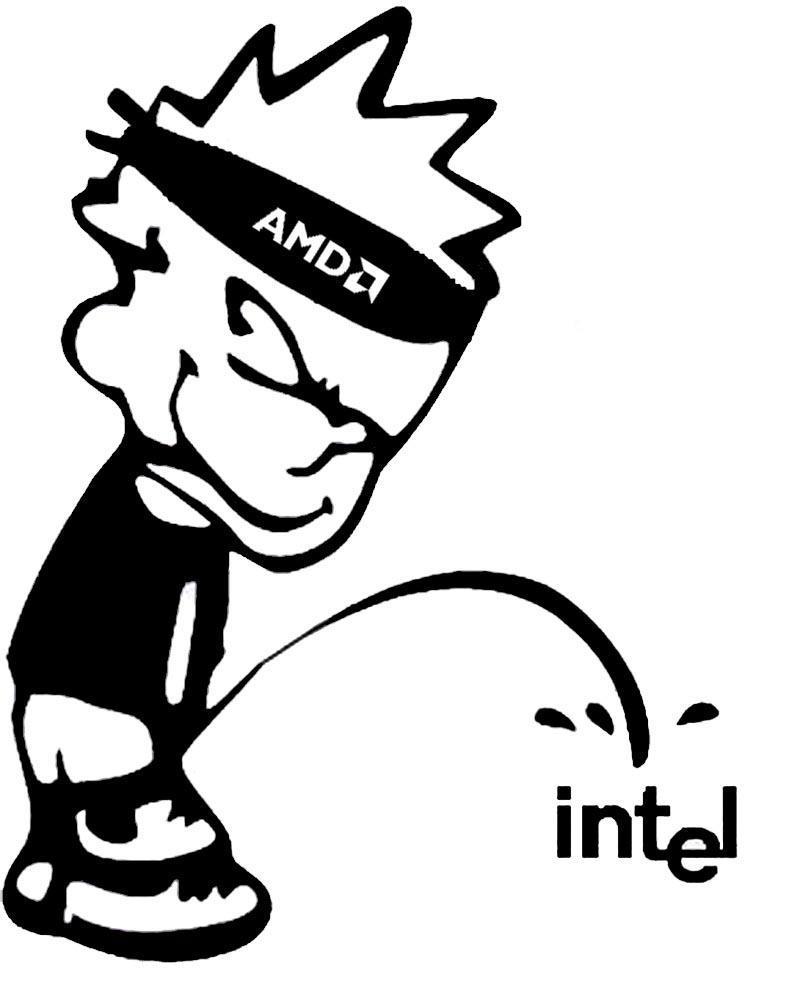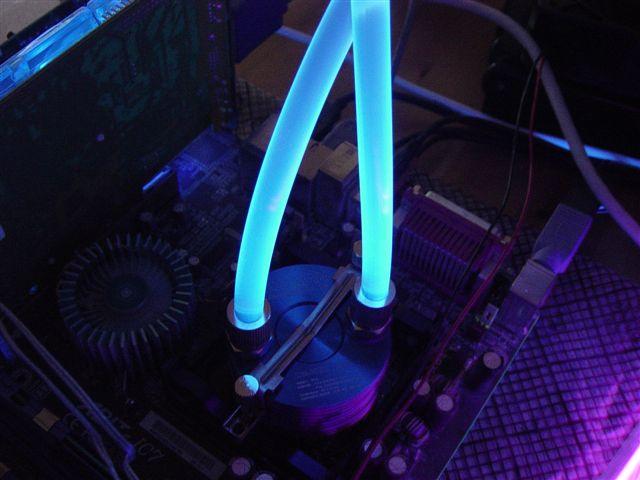ATi R520 er et problembarn
Diverse d. 08. juni. 2005, skrevet af red_martians 25 Kommentarer. Vist: 511 gange.
#1
Hm.. de skulle gå ned til 110nm teknologi i stedet for 90nm :l.
Men jeg tror at ATi snart får løst problemet og banker nVidia :P
Eller rettere sagt, HVIS de får løst problemet tror jeg de kommer med en bedre chip end nVidia.
Men det kan nok godt gå hen og blive dyrt for dem..
Men jeg tror at ATi snart får løst problemet og banker nVidia :P
Eller rettere sagt, HVIS de får løst problemet tror jeg de kommer med en bedre chip end nVidia.
Men det kan nok godt gå hen og blive dyrt for dem..
#2
Det kan gå hen og blive utroligt dyrt for dem desværre. Og er kedeligt at høre at det er et "problembarn" :l
- Vi må håbe dde snart kan få sat Nvidia på plads :e
- Vi må håbe dde snart kan få sat Nvidia på plads :e
#3
Hehe de har vel allerede sat nvidia på plads, ati's x850xt slår vel et 6800 u. Men fuck det, jeg er stadig glad for mit nvidia kort :) Og det er lang tid siden nVidia sidst har sendt noget nyt ud, så der bliver garanteret kamp til stregen inden længe (igen igen).
#4
Lad os nu se hvorvidt de rygter holder eller ej. Det er meget muligt at det er sandt, men det er også eget muligt at det er plantet bevidst af den ene eller anden grund ;)
#5
Hmm.. Det er vel et eller andet sted naturligt.
Vi ser det jo overalt hvor der er 2 der ejer markedet. Hvis den ene fejler vinder den anden bare markedet indtil de andre får lavet noget nyt. Det ligger jo hele tiden og svinger, det gør det jo også med intel og amd.
Nv har været knapt så heldig med deres 5xxx serie og brugt 6xxx til at komme lidt tilbage, jeg tror virkelig at deres g70 er et langt bedre produkt end hvad de tidligere har lavet, tror det kan måle sig med gf 256 :) At aTi MÅSKE har lavet en fejl er på sin vis meget fedt, men det er mest fordi at det afbalancere "løbet" en smule.
Som Lars siger kan det jo også været rygter som aTi selv har plantet så de slår endnu hårdere når den så kommer på markedet og alle tror den er "dårlig".
"Patience, my young padawan"
Mvh. Rage
Vi ser det jo overalt hvor der er 2 der ejer markedet. Hvis den ene fejler vinder den anden bare markedet indtil de andre får lavet noget nyt. Det ligger jo hele tiden og svinger, det gør det jo også med intel og amd.
Nv har været knapt så heldig med deres 5xxx serie og brugt 6xxx til at komme lidt tilbage, jeg tror virkelig at deres g70 er et langt bedre produkt end hvad de tidligere har lavet, tror det kan måle sig med gf 256 :) At aTi MÅSKE har lavet en fejl er på sin vis meget fedt, men det er mest fordi at det afbalancere "løbet" en smule.
Som Lars siger kan det jo også været rygter som aTi selv har plantet så de slår endnu hårdere når den så kommer på markedet og alle tror den er "dårlig".
"Patience, my young padawan"
Mvh. Rage
#6
#5: Måske de selv har plantet det.. Men så er de også ualmindelig dumme. :00 Hvis kortet har så store problemer som rygtet siger, vil folk jo springe på G70 istedet for, og de vil miste en masse kunder selv. Hvis der er nogle der har plantet det, så er det nVidia, for at de kan virke stærkere og få et stærkere image ved præcentationen :)
#7
Syns hele tiden at ATI lød så sikre med deres R520, men de kommer til at tabe meget på den lange ventetid.
nVidia får vist et lille forspring... lidt trist. Ville gerne have en direkte kamp...
nVidia får vist et lille forspring... lidt trist. Ville gerne have en direkte kamp...
#8
Ja jeg venter nu altså til man rent faktisk kan købe et af de nævnte kort før jeg beslutter mig til hvem der har "vundet" denne runde.... ;)
#9
#7: Hvis du kan huske NV30 var den midst ligeså omspændt af mystik som R520... nVidia var meget sikre på det grafikkort... Det var vist mest pga. deres kunder :(
#10
syntes entlig det er morsomt.
når nvidia har problemer griner folk af dem og siger de er lamme .
når ati har problemer forde de forsøger lave noget forhurtig er det synd for dem.
nej det er squ ikke de har godt af at finde ud af de ikke er gud :e
jeg håber personligt nv70 smadre ati :e
når nvidia har problemer griner folk af dem og siger de er lamme .
når ati har problemer forde de forsøger lave noget forhurtig er det synd for dem.
nej det er squ ikke de har godt af at finde ud af de ikke er gud :e
jeg håber personligt nv70 smadre ati :e
#11
#10: jeg er enig...... for 3år siden var det lige omvendt... folk lo ondt af deres Radeon8500.... især da Geforce4 kom... Så kom Radeon9700 og slog bunden væk under nvidia... Alle syntes det var syndt for nvidia, og råbte meget højt om den kommende NV40der skulle være lavet i samarbejde med 3dfx og nvidia.... Da folket endelig så NV30's resultater begyndte fanboy rundt omkring næsten at begå selvmord og blive alkoholikere.
Det her fanboy-snak er forfærdeligt.. og minder mig næsten om tiderne mellem backstreetboys og take-that.....
Konklusionen må være et fan"boys" vist mangler noget mellem benene ;)
Lad dog ATi fejle lidt, og lade nVidia komme lidt tilbage igen.. Hvis der er nogle der har fortjent det er det vist nvidia. der har arbejdet hårdt for at give os nogle spændende alternative produkter det sidste års tid. Geforce6600GT er f.eks. et af dem, og det er selv ATi-fans ved at indse.
ATi har haft deres storhedstid.... det har nvidia også... men markedet har brug for forandring!!
Det her fanboy-snak er forfærdeligt.. og minder mig næsten om tiderne mellem backstreetboys og take-that.....
Konklusionen må være et fan"boys" vist mangler noget mellem benene ;)
Lad dog ATi fejle lidt, og lade nVidia komme lidt tilbage igen.. Hvis der er nogle der har fortjent det er det vist nvidia. der har arbejdet hårdt for at give os nogle spændende alternative produkter det sidste års tid. Geforce6600GT er f.eks. et af dem, og det er selv ATi-fans ved at indse.
ATi har haft deres storhedstid.... det har nvidia også... men markedet har brug for forandring!!
#12
Håber nu at der vil komme kamp til stregen..! Personligt holder jeg ikke med nogle af dem, men synes da at det er surt for ATI at det går dårligt.. Det er synd hvis kortet går i vasken til fordel for nvidia, men har da også den mening hvis det gik omvendt.. Vil dog vente at se hvad det blir til.. Grunden til at jeg måske generelt hælder mest til ATI er nok pga. deres generelt lavere strømforbrug og den gode ydelse.. Krydser fingre for dem begge..!
#13
#11 mener du ikke #10 :P
var lidt ond ved ati , men ja det er da sjovest når de liger lige eller tæt på.
6800gt et ret fedt kort enig.
men jeg savner 3dfx
var lidt ond ved ati , men ja det er da sjovest når de liger lige eller tæt på.
6800gt et ret fedt kort enig.
men jeg savner 3dfx
#14
havde X800 serien ikke også problemer med at yielde 16 pipes? altså x800xt kortet.. jeg synes de var mega svært at få fat på for folk i dk til at starte med.
Devil_dk, så siger vi da bare, Så kan de lære det ;) :e
Devil_dk, så siger vi da bare, Så kan de lære det ;) :e
#15
#14: det var et helt andet problem.. For der havde OEM-fabrikanterne sat sig på alle deres grafikkort. nVidia havde vist et par problemer med lidt dårlige yields pga. mange transistorer. ATi har vist generelt haft gode yilds pga. deres chips meget generelt har få transistorer. Men det går måske galt for dem den her gang!
#16
ahaa så kan jeg da bedre forstå at min computer den har opført sig så mærkeligt og hvorfor at jeg ikke har fået så mange marks i 3dmark 03 men hva faen jeg er da ligeglad med scoren for det vigtigeste er at den bare virker
#17
->#16
?:(
Ja, fanboysnak er faktisk klamt..
Imo er de lige gode.. nVidia sidder bare mere på midend, mens ATi sidder på high-end synes jeg.
Men har jo selv geforce og dem kan jeg også bedst lide :)
Jeg kunne bare godt tænke mig at se et VILDT kort nu.. fra begge sider :D;)
?:(
Ja, fanboysnak er faktisk klamt..
Imo er de lige gode.. nVidia sidder bare mere på midend, mens ATi sidder på high-end synes jeg.
Men har jo selv geforce og dem kan jeg også bedst lide :)
Jeg kunne bare godt tænke mig at se et VILDT kort nu.. fra begge sider :D;)
#18
#17 - ATi sidder jo ikke på high-end når du smider 2x 6800U i :00 :P
og kan seriøst ikke se hva folk har så meget imod gf5 serien.. Mit 5900xt klarer sig da helt fint ?:(
Har lige købt HL2 med CS:S.. Selv om jeg hader CS så har jeg da lige prøvet det.. I Benchtesten får jeg gennemsnit på 72fps, er det ikke meget fint?
og kan seriøst ikke se hva folk har så meget imod gf5 serien.. Mit 5900xt klarer sig da helt fint ?:(
Har lige købt HL2 med CS:S.. Selv om jeg hader CS så har jeg da lige prøvet det.. I Benchtesten får jeg gennemsnit på 72fps, er det ikke meget fint?
#19
#18: så kender du vist ik helt til nvidia's driver-fusk.. og den måde half-life2 er bygget op på.
Da nvidia så hvordan de fik tæsk af ATi, så de at pixelshader 1.4 faktisk i mange tilfælde ser ligeså godt ud som pixelshader 2.0... og pixelshader 1.4fungerede meget bedre med nvidia-kort, så de roddede lidt op i deres driver, og fik dem til at fuske sig udenom ps2.0. og bruge 1.4 istedet for.
Hvad angår halflife2 er det den modsatte vej.. Her har spilproducenten indbygget en detektor, så når den ser et geforceFX-kort ændre den spilkoden til DX8 istedet for DX9... Flere har prøvet at køre at GeforceFX5900 med DX9.0 (de var inde og rode i spillets basale opbygning) og her opnåede de rent slideshow.
(Det hjælper ikke at ændre fra dx.9 til dx9 i spillet, den vil stadig arbejde som dx.8)
http://www.firingsquad.com/har...
Da nvidia så hvordan de fik tæsk af ATi, så de at pixelshader 1.4 faktisk i mange tilfælde ser ligeså godt ud som pixelshader 2.0... og pixelshader 1.4fungerede meget bedre med nvidia-kort, så de roddede lidt op i deres driver, og fik dem til at fuske sig udenom ps2.0. og bruge 1.4 istedet for.
Hvad angår halflife2 er det den modsatte vej.. Her har spilproducenten indbygget en detektor, så når den ser et geforceFX-kort ændre den spilkoden til DX8 istedet for DX9... Flere har prøvet at køre at GeforceFX5900 med DX9.0 (de var inde og rode i spillets basale opbygning) og her opnåede de rent slideshow.
(Det hjælper ikke at ændre fra dx.9 til dx9 i spillet, den vil stadig arbejde som dx.8)
http://www.firingsquad.com/har...
#20
#5 Det ville nok være det dummeste træk. Det ville være rigtig at der ville være mulighed for at ramme hårdere.
Lige nu ser det tydeligt ud til at nvidia udgiver deres gfx først. Hvis folk tror at ati's kort er det værste omgang lort. Tøver de ikke med at købe nvidia's kort. Hvis de derimod hved at ati kommer med et rigtig kort kort venter de selfølgelig.
Lige nu ser det tydeligt ud til at nvidia udgiver deres gfx først. Hvis folk tror at ati's kort er det værste omgang lort. Tøver de ikke med at købe nvidia's kort. Hvis de derimod hved at ati kommer med et rigtig kort kort venter de selfølgelig.
#21
Sikke en trist nyhed x(
Lad os så håbe at de for problemer løst så vi kan få gang i en ATI vs. Nvidia krig
Lad os så håbe at de for problemer løst så vi kan få gang i en ATI vs. Nvidia krig
#22
#21 hvorfor håbe på en krig når man kan få en helt ny deltager ?
Hvem var det der kom med nogle ganske udemærkede midend kort ? Det må Red_martians vide :)
Volari eller såen noget pjat.
Vil sgu ha' noget mere kamp, alt det her 1on1 gør at udviklingen tit bliver lidt ensformig og trist. Flere spillere betyder mere inovativt og lavere priser, somregl...
Hvem var det der kom med nogle ganske udemærkede midend kort ? Det må Red_martians vide :)
Volari eller såen noget pjat.
Vil sgu ha' noget mere kamp, alt det her 1on1 gør at udviklingen tit bliver lidt ensformig og trist. Flere spillere betyder mere inovativt og lavere priser, somregl...
#23
Nice ATi, så ser den sidste kortseries (X800) store problem ud til at blive endnu større:
Kort med fuldt antal pipes (dengang 16, nu 32) vil blive givet til udvalgte personer mens de mindre heldige kort (dengang X800PRO nu 16/24-pipe-kort) vil blive spammet ud over markedet.. :)
Kort med fuldt antal pipes (dengang 16, nu 32) vil blive givet til udvalgte personer mens de mindre heldige kort (dengang X800PRO nu 16/24-pipe-kort) vil blive spammet ud over markedet.. :)
#24
#22: der er faktisk 2 ret spændende ekstra deltagere på markedet. S3's GammaChrome ser rigtig fed ud især topmodellen S19, som vi desværre ikke har set endnu. Det har vi tilgengæld med XGI Volari 8600. Det siges den kommer med 96MB ram (ret lavt af sådan et kort) til gengæld vil det have extreme-cache (fuld udnyttelse af system-rammene), så det reelt har 96MB lynhurtig ram"cache" og derud over ca. 256MB den kan tage for sig af system-rammene.
De 96MB vil arbejde med 450Mhz mod nvidia's 128MB ved 500Mhz.
Tilgengæld vil Volari's være 192 bit hvor Geforce6600GT har 128bit.
Det der bliver mest spændende ved volari er sådanset chippen. Vil den arbejde ligeså effektivt som Geforce6600GT. Personligt tror jeg det ikke, men det bliver da spændende at lege med.!
De 96MB vil arbejde med 450Mhz mod nvidia's 128MB ved 500Mhz.
Tilgengæld vil Volari's være 192 bit hvor Geforce6600GT har 128bit.
Det der bliver mest spændende ved volari er sådanset chippen. Vil den arbejde ligeså effektivt som Geforce6600GT. Personligt tror jeg det ikke, men det bliver da spændende at lege med.!
#25
Konkurrence er generelt sundt - uanset om det er AMD vs. Intel eller Ati vs nVidia, Microsoft vs nåh nej - øv!
Men man skal nok ikke glemme at almindelige konkurrenceparametre fra almen industri gælder ikke i den fagre computerverden - den livslængde et produkt har - i det mindste som markedsleder og dermed retningsgivende er megakort.
Derfor vil der - ikke mindst i tider hvor man forsøger at krybe 20 nanometer af gangen - genereres dårlige yields, og derfor overhaler to relativt jævnbyrdige firmaer hinanden med jævne mellemrum - 3 - 6 mdr. Jeg er flintrende ligeglad med fabrikatet - men interesserer mig for om det kan drive de spil jeg er interesseret i - og den store vinder lige nu er i mine øjne 6600GT - der erstatter 4200 og 5900XT som bang for the buck.
May the best company win - og så står rekorden sikkert max 6 mdr. og så er det den anden der er forrest - eller hur?
Tomgun
Men man skal nok ikke glemme at almindelige konkurrenceparametre fra almen industri gælder ikke i den fagre computerverden - den livslængde et produkt har - i det mindste som markedsleder og dermed retningsgivende er megakort.
Derfor vil der - ikke mindst i tider hvor man forsøger at krybe 20 nanometer af gangen - genereres dårlige yields, og derfor overhaler to relativt jævnbyrdige firmaer hinanden med jævne mellemrum - 3 - 6 mdr. Jeg er flintrende ligeglad med fabrikatet - men interesserer mig for om det kan drive de spil jeg er interesseret i - og den store vinder lige nu er i mine øjne 6600GT - der erstatter 4200 og 5900XT som bang for the buck.
May the best company win - og så står rekorden sikkert max 6 mdr. og så er det den anden der er forrest - eller hur?
Tomgun










